The week at a glance
- Possible Short-tailed Shearwater in Co. Clare
- Probable Yelkouan Shearwater in Cornwall
- Possible Masked Booby in Norfolk
- Probable Black-browed Albatross in Dumfries & Galloway
- Possible Audouin's Gull in Cornwall
- Sykes's Warblers in Northumberland and Shetland
- House Finch in Devon
It must be a whole couple of weeks since we featured a long list of 'possible' mega seabirds. This week saw more than its fair share, although these were all brief fly-bys that tantalised as much as anything.
First up was a possible Short-tailed Shearwater west past the Bridges of Ross (Co. Clare) on morning of 18th. There are no further details on this bird, which will be rather difficult to prove without good views as this is an incredible record of a bird more associated with the Pacific. There is just one previous claim, off Flamborough (East Yorkshire) on 27th July 1997, though it was not accepted by BBRC. An equally difficult identification challenge is Yelkouan Shearwater, and there was another 'probable' past Porthgwarra (Cornwall) on 18th, the seventh there this year alone.
Almost of equal status was a possible juvenile Masked Booby seen heading past Mundesley and Sea Palling (Norfolk) on 12th. Juvenile Gannet is the obvious confusion species, although with reasonable views (as are always had on seawatches!) identification isn't too difficult. To add to the mix, there have been recent records of both Brown Booby — in Spain, in July and August — and immature Red-footed Booby — photographed off the coast of Spain on 11th August. There are several records of Masked Booby from France and Spain, and recent British claims in 2007 (Isle of Wight, Dorset and Cornwall) and another in Cornwall in 2009, though none are as yet accepted.
Not quite as rare, but presumably far more spectacular, was the probable Black-browed Albatross that passed Corsewall Point (Dumfries & Galloway) on 14th.
Last up was a split-second view of a possible immature Audouin's Gull, seen by one observer on the Camel Estuary (Cornwall) on 15th. It headed past in mid-afternoon but couldn't be relocated, though those looking did find a Quail!
Highlight of the week, though, was a Sykes's Warbler at Druridge Bay (Northumberland) on 15th–16th. Identification will always prove problematic, but recent advances have made this less of a dilemma. A combination of features seemed to confirm this as a Sykes's (rather than a Booted), though the bird was never very obliging. This was a welcome addition to many lists, with the only other mainland British records being one-day birds at Portland (Dorset) in 2000, Sheringham (Norfolk) in 2002 and Beachy Head (East Sussex) in 2002.
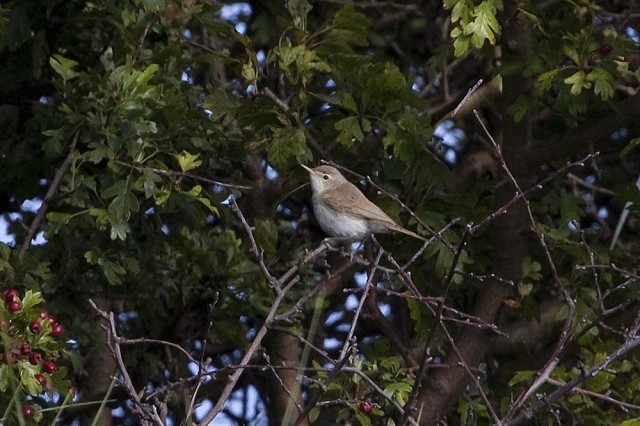
Sykes's Warbler, Druridge Bay CP, Northumberland (Photo: Tim Mason)
A more typical location would be Shetland, with five previous records, so the islands obliged with a more showy bird at Burrafirth, Unst on 16th–17th. This is quite typical timing for this species, with five of the eleven previous records being found in August.
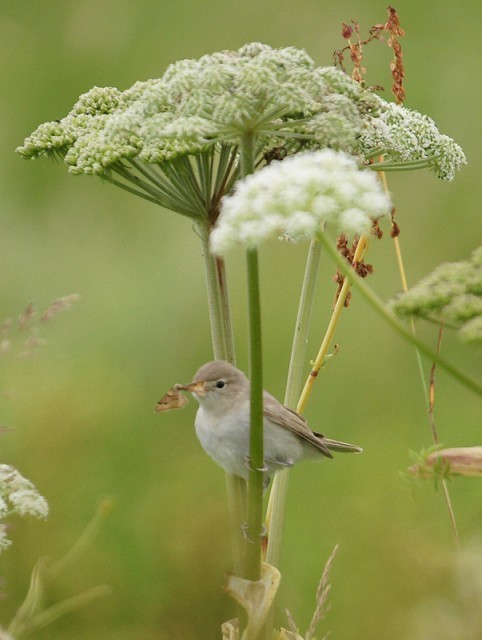
Sykes's Warbler, Burrafirth, Unst, Shetland (Photo: Mike Pennington)
Last but not least among the megas, the now red House Finch was still present, if very elusive, at East Prawle (Devon), reported on 15th and 17th.
Arrivals of wildfowl sure to cause some debate continued, with two adult and three juvenile Snow Geese found with Greylags at Stromness (Orkney) on 17th. Add to this the continued presence of two Ruddy Shelduck at Montrose Basin (Angus & Dundee) to 15th, with one at Hornsea Mere (East Yorkshire) until 12th, a pair at Pentney Gravel Pits (Norfolk) on 12th–17th and one in fields at Southwold (Suffolk) on 14th. Is this increase in records due to increased occurrence or increased reporting?
Presumably less contentious was an adult drake Black Duck on Sruhill Lough, Achill Island (Co. Mayo) on 16th, though when it might have arrived this side of the Atlantic is an interesting question. Proving harder to pin down was the eclipse drake Blue-winged Teal that turned up again at Fen Drayton (Cambridgeshire) on 14th. When I say "turned up again" I mean "was picked up again after moulting".
Other lingering wildfowl included the female Ferruginous Duck at Minsmere (Suffolk) on 13th, the drake at Chew Valley Lake (Somerset) to 17th and the eclipse drake Ring-necked Duck at Angle Park (Fife) until 14th at least. Interestingly, one, possibly two, more were reported at Loch Leven (Perth & Kinross) on 16th. In Aberdeenshire, four drake Surf Scoters were still at Blackdog on 12th, with three there on 17th, and a redhead Smew was at Loch of Strathbeg on 16th (with 3 Scaup).

Ring-necked Duck, Angle Park GP, Fife (Photo: Willie McBay)
At sea, there were few records of Cory's Shearwater, with just a probable distantly off St Ives (Cornwall) on 12th, one past Holme next the Sea (Norfolk) on 13th and two from a pelagic off Co. Cork on 15th. The same pelagic also recorded three Great Shearwaters and, also in Ireland, six passed Bridges of Ross (Co. Clare) on 17th (with four there on 18th) and two passed Cape Clear (Co. Cork) on 18th. The only other reports were off Fife Ness on 15th and off the Isles of Scilly pelagic on 18th.
The largest, and most regular, counts of Sooty Shearwater came from the east, with 60 north past Fife Ness on the afternoon of 15th and 29 past Whitburn (Durham) on 13th. In the west, the peak counts were 55 past Bridges of Ross (Co. Clare) on 18th and 22 past Pendeen (Cornwall) on 12th. Numbers of Balearic Shearwater were down this week, with peak counts of 30 past Pendeen on 12th, 22 past Porthgwarra (Cornwall) on 12th (with seven Sooty Shearwaters) and 11 past Borth (Ceredigion) on 16th. East-coast records included singles past Fife Ness, Barns Ness (Lothian), Whitburn (Durham) on several dates, Cley (Norfolk), Hartlepool Headland (Cleveland) and two past Low-Newton-by-the-Sea (Northumberland) on 14th.

Sooty Shearwater, Whitburn Coastal Park, Durham (Photo: Mark Newsome)

Balearic Shearwater, Corsewall Point, Dumfries & Galloway (Photo: Gavin Chambers)
Considering Azores birders are currently enjoying a record influx of Wilson's Storm-petrels (photos here), it was perhaps surprising that the only ones reported here were from a fishing boat off Slyne Head (Co. Galway) on 12th and off the Isles of Scilly pelagic on 18th.
Other seabirds included two unexpected guests in Cambridgeshire: a juvenile Shag at Ferry Meadows on 16th–18th and a Gannet over Peterborough on 16th.
The Glossy Ibis remained at Tacumshin (Co. Wexford) all week and there was a rush of records from the south coast: one at Stanpit Marsh (Dorset) on 12th–14th that roosted in The Nursery at Hengistbury Head on 12th, one briefly with Little Egrets at Upton, Poole (Dorset) on 13th and one at Keyhaven Marshes (Hampshire) in the late evening of 14th and early morning of 15th.
There was no sign of any Little Bitterns but the Purple Herons continued to perform at Dungeness (Kent), where an adult and juvenile were seen on and off all week. There was just one other record, of a juvenile at North Foreland (Kent) on 14th. The Dungeness Great White Egret also remained all week, with others at Lady's Island Lake (Co. Wexford), Arne (Dorset), Blashford Lakes (Hampshire), Broad Lough (Co. Wicklow) and Damerham (Hampshire). Two also remained at Shapwick Heath and Meare Heath (Somerset) until 17th.

Great White Egret, Lady's Island Lake, Wexford (Photo: Paul & Andrea Kelly)
Not content with the previous two species, Dungeness also hosted the Cattle Egret that remained until 18th. The various records from Cambridgeshire may have related to the same bird: at Earith until 16th, Ouse Washes on 15th and again roosting at Needingworth Quarry Lakes on 16th. There was also one on the saltmarsh at Hole Haven, Canvey Island (Essex) on 17th–18th.
Spoonbills were still spread widely across the south, with peak counts of 15 at each at Cley (Norfolk), Havergate Island (Suffolk) and Gibraltar Point (Lincolnshire). One of the 15 at the latter site was a recently fledged juvenile, presumably from the Holkham colony, begging food from an adult — a hilarious sight! In Ireland, singletons were seen at Shannon (Co. Clare) and Quoile Pondage (Co. Down) with two at Killongford (Co. Waterford).
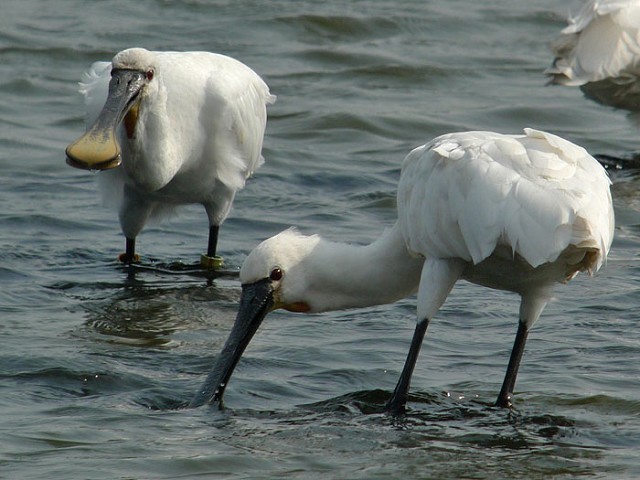
Spoonbill, Gibraltar Point NNR, Lincolnshire (Photo: Russell Hayes)
'The' Spotted Crake remained at Grove Ferry (Kent) all week, though the appearance of two together on 18th makes you wonder how long it's been there. There was then another at Shibdon Pond (Durham) on 15th–18th. On the wader front, the adult Pacific Golden Plover was still on South Uist (Outer Hebrides), at Ormiclate until 12th. Returning Dotterel were seen at West Carlton (East Yorkshire) until 12th, in the beach car park at Winterton (Norfolk) briefly on 16th and at Horwich (Manchester) and Oare Marshes (Kent) on 18th.

Spotted Crake, Grove Ferry NNR, Kent (Photo: Marc Heath)

Dotterel, Oare Marshes NR, Kent (Photo: Mick Southcott)
The departure of some of the American waders was matched by the arrival of three Buff-breasted Sandpipers: one around the beach huts at Snettisham (Norfolk) on 13th (the site also held an impressive 13 Spotted Redshank), a juvenile at Lough Donnel (Co. Clare) on 15th–17th and one on the ARC Pit at Dungeness (Kent) on 15th–16th. There was also a Pectoral Sandpiper again at Vane Farm (Perth & Kinross) on 18th.

Buff-breasted Sandpiper, Dungeness RSPB, Kent (Photo: Paul Kerry)
The adult Lesser Yellowlegs remained at Inner Marsh Farm (Cheshire) until 16th and the Isles of Scilly bird moved from Big Pool, St Agnes, to Great Pool, Tresco, staying until 16th. The islands also saw the only Grey Phalaropes of the week, two off the pelagic on 15th.
The aged Ring-billed Gull was still at Rossi's Ice Cream Parlour in Westcliffe-on-Sea (Essex) on 14th and another adult was at the roost at Alston Reservoir (Lancashire) on 16th and 17th. Other long-staying gulls included the moulting Laughing Gull at Ballycastle (Co. Antrim) to 13th, and the third-summer Glaucous at Kilrush (Co. Clare) on 14th, with the only other an adult at Port Nis, Lewis (Outer Hebrides) on 18th.

Ring-billed Gull, Alston Reservoirs, Lancashire (Photo: Gavin Thomas)
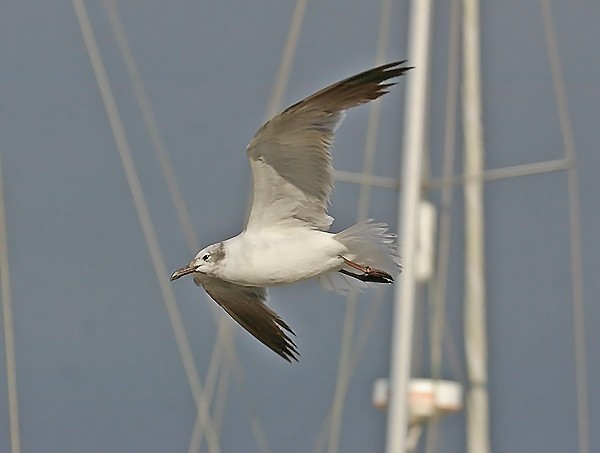
Laughing Gull, Ballycastle, Antrim (Photo: Derek Charles)
There were fewer records of Caspian Gull than of late, with the peak counts of just four at Nar Valley Fisheries (Norfolk) on 13th and Pitsea (Essex) on 13th. Sabine's Gulls, however, were well recorded, with adults past Bridges of Ross (Co. Clare) on 12th and Whitburn (Durham) on 14th (along with four Sooty Shearwaters and 21 Roseate Tern), one briefly at Farmoor Reservoir (Oxfordshire) on 14th and two past Kilcummin Head (Co. Mayo) on 13th. One also passed Winterton (Norfolk) on 15th.
The juvenile Whiskered Tern remained at Saltholme (Cleveland) to 18th and there was a flush of records of juvenile White-winged Black Terns. One was at Hornsea Mere (East Yorkshire) on 14th–18th, and one over the Patch at Dungeness (Kent) on 15th may have been the same as the probable on the outfall at Cross Ness (London) on 16th and then at nearby Rainham Marshes on 17th.

White-winged Black Tern, Rainham Marshes RSPB, Greater London (Photo: James Lowen)

White-winged Black Tern, Hornsea Mere, East Yorkshire (Photo: Garth Clarke)
In Ireland, the female Snowy Owl returned to Blacksod (Co. Mayo) on 12th, reported again on 15th. It is rather interesting to think where she might have been all summer, and whether she has raised a family since.
The highlight of the week for many were the first northeasterlies of the autumn, which lived up to expectations. East-coast Bird Observatories were popular, so from north to south:
Fair Isle (Shetland): Arctic Warbler and Barred Warbler on 14th
North Ronaldsay (Orkney): Barred Warbler on 15th

Barred Warbler, North Ronaldsay, Orkney (Photo: Paul A Brown)
Filey (North Yorkshire): Icterine Warbler on 14th; Barred Warbler on 15th.
Flamborough (East Yorkshire): two Icterine Warblers, Ortolan Bunting, Wryneck and Red-backed Shrike on 14th; Icterine Warbler, Wryneck and Red-backed Shrike on 17th; Red-backed Shrike and Icterine Warbler on 18th.
Spurn (East Yorkshire): Icterine Warbler, Red-backed Shrike, Wryneck, 17 Pied Flycatchers, five Whinchats and an early Fieldfare on 14th; the site's second Citrine Wagtail, three Icterine Warblers, Red-backed Shrike and 11 Whinchats on 15th.
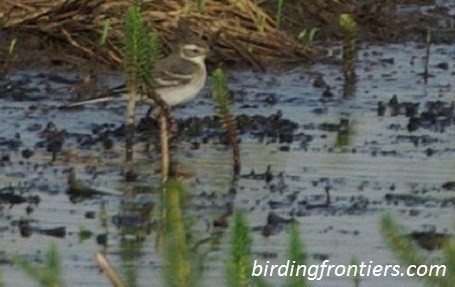
Citrine Wagtail, Spurn, East Yorkshire (Photo: Martin Garner)
Gibraltar Point (Lincolnshire): Red-backed Shrike on 16th–18th
Sandwich Bay (Kent): Icterine Warbler on 12th.
Dungeness (Kent): Barred Warbler on 14th; Red-backed Shrike on 16th–18th.

Red-backed Shrike, Dungeness, Kent (Photo: Mick Southcott)
Elsewhere, there were Wrynecks at Hartlepool Headland (Cleveland) on 13th–14th and Blakeney Point (Norfolk) on 13th and other Red-backed Shrikes at Whitburn Coastal Park (Durham) on 14th, Newton Pool (Northumberland) on 15th–17th, Rimac (Lincolnshire) on 16th and Reculver (Kent) on 18th. The first Lesser Grey Shrike of the year was a rather smart male at Kelling (Norfolk) on 17th–18th. There are now over 20 records in Norfolk, by far the most in any county bar Shetland.

Wryneck, Hartlepool Headland, Cleveland (Photo: Ian Forrest)
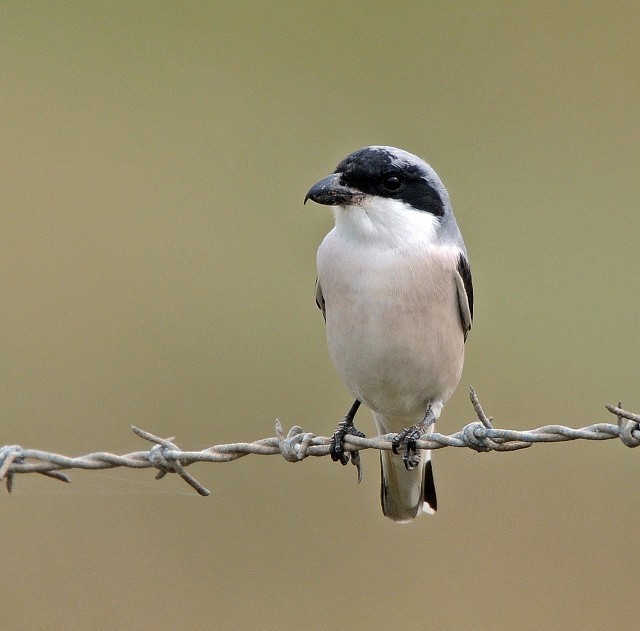
Lesser Grey Shrike, Kelling, Norfolk (Photo: Jon Evans)
Other Barred Warblers were recorded at Long Nab (North Yorkshire) and Unst (Shetland) on 14th, Warsett Hill (Cleveland) on 14th–15th, Out Skerries (Shetland) on 16th, Pool of Virkie (Shetland) on 17th and on the Farne Islands (Northumberland) and at Port Nis, Lewis (Outer Hebrides) on 18th.
Other Icterine Warblers were on Blakeney Point (Norfolk) on 13th–15th, Burnham Overy (Norfolk) and Sammy's Point (East Yorkshire) on 15th, Minsmere (Suffolk) and Wester Quarff (Shetland) on 17th and a probable briefly at Felixstowe Ferry (Suffolk) on 17th. There was also one further Arctic Warbler, at Haroldswick, Unst (Shetland) on 18th.

Icterine Warbler, Blakeney Point, Norfolk (Photo: Penny Clarke)

Arctic Warbler, Haroldswick, Unst, Shetland (Photo: Mike Pennington)
Following the Greenish Warbler at Queenamidda (Orkney), which remained to 12th, there was a possible heard in Wells Woods (Norfolk) on 14th–15th with another in Inverness (Highland) on 16th. In the west, three Aquatic Warblers were ringed on 15th, at Teifi Marshes (Pembrokeshire), South Milton Ley (Devon) and La Claire Mare (Guernsey), with a second bird ringed at Teifi Marshes on 18th and an unconfirmed report from Radipole Lake (Dorset) on 18th.

Aquatic Warbler, Teifi Estuary, Ceredigion (Photo: Marc Hughes)
The second Thrush Nightingale for the Farne Islands (Northumberland) was there on 14th, though rather more resident was the male white-spotted Bluethroat that was again at Welney (Norfolk) on 17th. It must surely now have finished moulting, hence may well depart soon. The only other passerine of note was a Common Rosefinch at Toab (Shetland) on 17th.
Photo of the Week
There is no Photo of the Week this week due to staff holidays. There will be a double edition next week.

